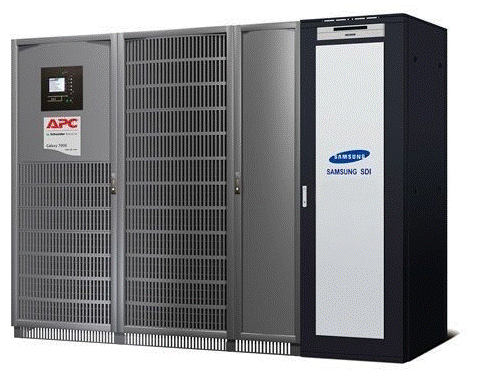
TECHNOLOGY
ESS plus UPS, UES is now rising
ALL > Technology
'ESS', an energy refrigerator
ESS (Energy Storage System) stores electricity during the less demanded hours, and supplies the saved electricity when the demand gets higher. ESS is used not only for saving when cheaper and supplying when expensive, but also for renewable energy including photovoltaic and wind power. Electric power generated by such energy has varying quality depending on weather or other external conditions, and the amount of supply is also irregular. ESS can be the solution to overcome such a problem.
Blackout? Never mind electricity, we have 'UPS' – Upgraded with lithium-ion battery
UPS (Uninterrupted Power System) is an electrical apparatus that provides emergency power when the input power fails. UPS is a sort of ESS that can provide stable power for a while with its built-in batteries when the external power source is blocked.
Especially in case of industry's production factory, unexpected power failure on the production line causes defective products as well as time loss for restarting the line, which result in tremendous damage to the company. Therefore, most plants, especially plants for high-tech IT products desperately need UPS installed in them in order to prevent power failure
Lead-acid battery has been mainly used for UPS so far, but recently they have been replaced by lithium-ion battery. Because drawbacks of lead-acid battery can be overcome by applying lithium-ion battery.
UPS with lithium-ion battery has higher energy density than lead-acid battery which make the installation space to be reduced by up to 1/3, and it also has high discharging efficiency so it can supply more electricity with the same capacity. Another advantages of lithium-ion battery are, that it has longer life span of 10 years than lead-acid battery whose replacement cycle is just 4 ~ 6 years, and that it has wide range of working temperature so the cost for air conditioning and heating can be saved

[Lithium-ion UPS, joint developed by Samsung SDI and Schneider Electric]
According to IMS Research, a global research firm, global UPS market is forecast to rapidly grow by 6.5% each year, from 10.4 billion dollar in 2015 to 14.3 billion dollar in 2020. As the UPS market grows, demands for lead-acid battery has been gradually replaced by lithium-ion battery.
From 2012, Samsung SDI started to provide lithium-ion battery for UPS to Duzon IDC and Shinhan bank's new IDC, expanding its business.
(Unit: 100 million dollars, Source: IMS research)
Blackout prevention plus cost reduction. UES (ESS + UPS) is coming]
- UES began operating UES in Sansung SDI Uiwang R%D center
Samsung SDI developed UES, UPS with ESS functionality, and began operating it. UES is a combined term of UPS and ESS, so UES has also combined functionalities of UPS, which prevents power failure and UES, which saves the cost of electricity by storing electric energy in the nighttime when it is less expensive and supplying it during the peak hours.
Samsung SDI applied its independently developed EMS (Energy Management System) which enables bi-directional energy exchange, having both functionalities of preventing power failure and saving electricity.
In addition, this newly developed UES has dramatically reduced number of parts, so the investment cost can be saved up to 30% in comparison with separate installation of UPS and ESS of the same capacity. We made it available to connect with all types of UPS model, so the existing UPSs can be easily converted to UES
In June 2013, Samsung SDI set up a dedicated team to develop UES. To ensure the maximum stability, we have cooperated with Samsung Electronics, designed and developed our products to be appropriate for semiconductor production line, the most sensitive place to power failure.
This UES was installed in Samsung SDI Uiwang R&D center for the first time in the world and began operating from April 1. We are planning to verify its stability in Uiwang R&D center where there are chemical research facilities and production line for electronic materials. From the second half of this year, we will expand our efforts for obtaining orders to the global market as well as affiliates of Samsung Group.
Samsung SDI, as the no.1 ESS company, will continue making efforts to create new business models like UES, developing a new market










